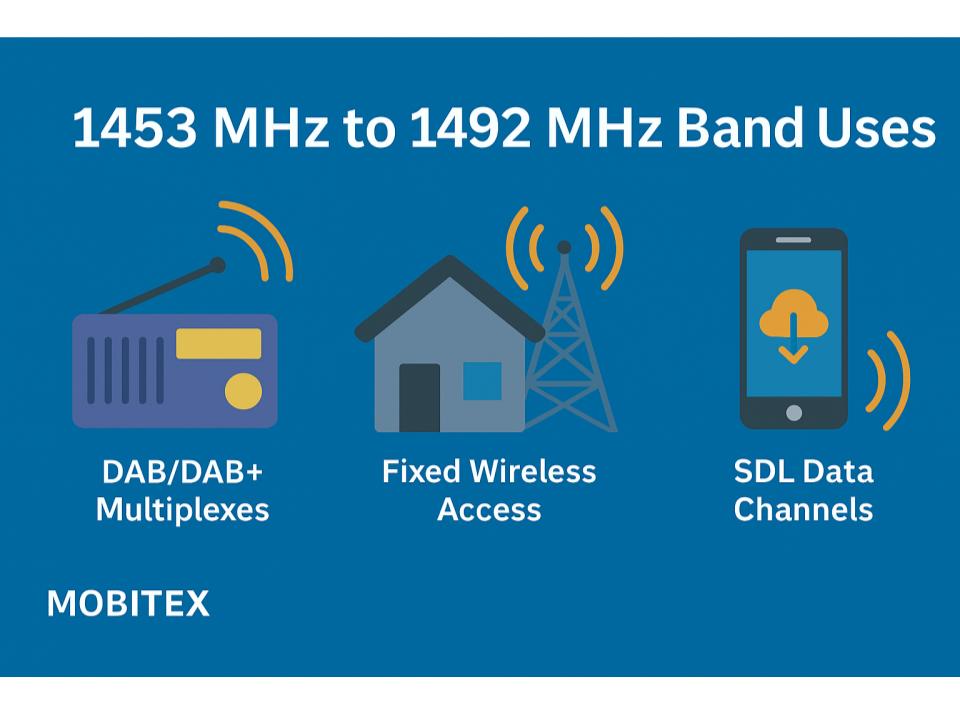📡 The 1453–1492 MHz band sits in the heart of the L-Band, a powerful transition zone between traditional broadcast systems and emerging mobile broadband technologies. Once dominated by Digital Audio Broadcasting (DAB), this spectrum is now central to Supplemental Downlink (SDL), Fixed Wireless, and 5G expansion efforts across multiple regions.
🌍 Global Spectrum Overview
Internationally, this band bridges long-established DAB broadcast allocations and the Mobile Satellite Service (MSS) segment that begins above 1492 MHz. The result is a spectrum block that supports both legacy and modern communication systems, offering exceptional propagation and compact antenna dimensions.

| ITU Region | Primary Services | Notes |
|---|---|---|
| Region 1 (Europe, Africa) | Broadcasting, Mobile, Fixed | Home of DAB/DAB+; supplemental downlink permitted in select markets |
| Region 2 (Americas) | Fixed, Mobile | Used experimentally for SDL and wireless broadband |
| Region 3 (Asia-Pacific) | Fixed, Mobile, Telemetry (secondary) | Under evaluation for 5G and regional broadcast applications |
📻 From DAB to Supplemental Downlink (SDL)
When DAB was introduced in the 1990s, much of this spectrum was reserved for digital radio multiplexes. Over time, as mobile broadband demand surged, regulators reclassified parts of the band for Supplemental Downlink (SDL) – a technique that boosts mobile network capacity by using downlink-only blocks for data delivery.
This flexibility means that in Europe, the band still carries DAB and DAB+ services, while in other regions it’s being repurposed for 4G and 5G downlink. The transition represents one of the clearest examples of broadcast and broadband convergence.
⚙️ Technical Characteristics
- Frequency Range: 1453 – 1492 MHz
- Band Family: L-Band (Broadcast / Mobile)
- Typical Bandwidths: 1.5–5 MHz
- Waveforms: COFDM (DAB), QPSK/OFDM (Broadband)
- Duplexing: Downlink-only (Simplex)
- Guardbands: ≥ 1 MHz at 1452 MHz and 1492 MHz edges
- Propagation: Excellent line-of-sight and moderate urban penetration
These characteristics make the band ideal for regional broadcast coverage and high-throughput downlink services. A ¼-wave antenna measures roughly 5 cm, simplifying integration into vehicles, handheld radios, and compact base stations.
🛰 Neighboring Bands
- Lower Neighbor (1427 – 1452 MHz): Fixed and Mobile Telemetry, MBANS, and Aeronautical applications
- Upper Neighbor (1492 – 1518 MHz): Mobile Satellite Service (MSS) and Supplemental Downlink extensions
Careful coordination at these boundaries is critical. The 1452 MHz edge must protect sensitive telemetry and MBANS operations, while the 1492 MHz edge aligns with satellite and broadband downlinks.
📶 Real-World Usage and Devices
- Applications: DAB/DAB+ multiplexes, fixed wireless access, SDL data channels
- Devices: Broadcast transmitters, vehicular tuners, portable DAB radios, mobile base stations
- Range: Typically 20–100 km line-of-sight
- EIRP: 43–65 dBm typical (base transmitters)
- Duty Cycle: Continuous (100 %)
In Europe, this band supports dense DAB networks and regional public-service broadcasters like BBC, NRK, and TDF. Other regions deploy it experimentally for LTE Band 32 or fixed broadband.
🔋 Ecosystem and Technology Outlook
- Ecosystem Maturity: Established (Europe), emerging elsewhere
- Refarming Potential: Ideal for LTE/5G Supplemental Downlink (SDL)
- Chipsets: DAB demodulators and Qualcomm L-Band prototypes
- Standards: ETSI EN 300 401 (DAB), ETSI TS 102 563 (DAB+)
The 1453–1492 MHz block offers an excellent balance between coverage and capacity, making it an attractive candidate for hybrid broadcast-broadband networks and NTN (non-terrestrial) experiments.
🧭 Summary
The 1453–1492 MHz band exemplifies how spectrum evolves alongside technology. Once home to radio broadcasting, it’s now a cornerstone for mobile data offload and hybrid communications. With strong propagation, flexible allocations, and global equipment support, this band continues to bridge the worlds of broadcast and broadband – and remains one of the most valuable slices of L-Band spectrum today.

